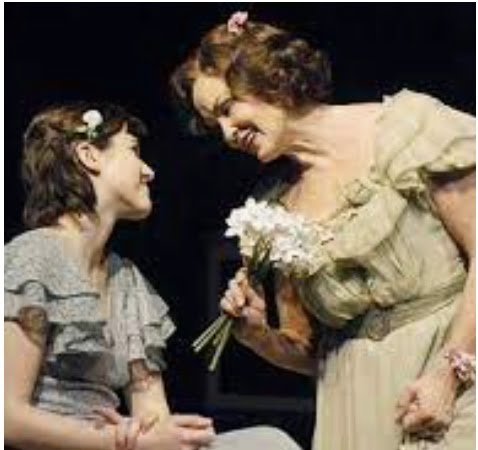Tennessee Williams's heart breaking play about his mother and sister directed by Rupert Goold
“The play is memory”
Tom Wingfield
This review of The Glass Menagerie is from 2007 in our archive
Interestingly, Jessica Lange is re-creating the role of Amanda Wingfield, the faded southern Belle and based on his own mother in Tennessee Williams’ The Glass Menagerie. The production was not ecstatically received in New York so only the lead actress has come to London.
Producer Bill Kenwright gives Ms Lange a new director and a British supporting cast. Increasingly high profile, Rupert Goold takes over directing the play and the other parts are recast with British actors. Ed Stoppard takes on the role of Tom, the writer who has to toil in a warehouse and, as his sister Laura, is newcomer Amanda Hale. Mark Umbers is the handsome Gentleman Caller.
I remember as a little girl having glass animals and I also remember how easily they broke. None of them survived my childhood because I was too clumsy. I found the play sad and emotional although they were people all around me in the audience who were claiming to be “really enjoying it!”
I can’t watch this play of Tennessee Williams without seeing what damage a mother can do to her children when she intends them no harm. Take the incident of the Secretarial College which Laura drops out of without telling her mother. The mother is trying to get the daughter an employable skill so that she doesn’t end up in poverty if no gentleman caller or potential husband materialises. The fact that the daughter is so socially inept that she cannot cope with the pace of the college, nor discuss this with her mother or brother, is very sad.
I suppose when Williams called his play The Glass Menagerie he was referring not just to the brittle fragility of Laura, but to the whole family: Amanda living in her fantasy past of what might have been and Tom tied down to a job he hates in order to support his deserted mother and sister financially as well as emotionally supporting the damaged young girl.
Rupert Goold has taken on board some of the reservations about the New York production and designer Matthew Wright sets this play in a sitting room with the dining room to the rear. The furniture is functional but almost shoddy. The cast iron fire escape drops from high above and curves round the room to form a terrace area. To the sides and rear are the shadowy images of ladders and stairs forming boxes and confining the players. A ring of spotlights sits high above the playing circle.
It is effective at putting the play in its Depression period and showing us a dreamlike interpretation of the psychological confines of dysfunctional families. The slow motion of family routines like meal times and the impression of faint tinkling music give the production its ethereal quality. The striped lighting effects are used to dim areas not in play. As Tom describes the dancehall, a motorised mirror ball bathes the stage with perforated spots of light.
Jessica Lange isn’t afraid to give an unsympathetic portrayal of Amanda as she badgers her daughter when her disappointment has risen to the surface. She looks ghastly in her Victorian muslin ball gown, the dress falling apart with age. Don’t we hate the way she swishes the full skirt in front of the Gentleman Caller to give a glimpse of her legs in a manner intended as flirtatious, but which is actually stomach churning. We see her desperation as she tries to sell to other members of the social club, the Daughters of the American Revolution.
In the final scene when Mrs Wingfield turns vitriolic with rage and her daughter crumbles up in a beautifully nuanced performance from Amanda Hale, the emotional index of the play is almost unbearable. When Mrs Wingfield says, “You live in a dream!” to Laura, we all think it’s a bad case of projection. It must have been very confusing for everyone to have the mother’s character having the same name as the actress playing the daughter!
Ed Stoppard seethes with the resentment of an artist who is stifled by obligation and shamed by the memories of his sister. He has the casting advantage with Amanda Hale looking as if they could be brother and sister, both dark haired, both with long sensitive faces with expressive eyes. To my English ears the Southern accents are adequate.
Mark Umbers is tall and handsome but even as he kisses Laura, no-one in the audience could surely believe that this play could have a happy ending.
Production Notes
The Glass Menagerie
Written by Tennessee Williams
Directed by Rupert Goold
Cast
Starring:
Jessica Lange
Amanda Hale
Tom Stoppard
Mark Umbers
Creatives
Director: Rupert Goold
Designer: Matthew Wright
Lighting Designer: Paul Pyant
Sound Designer: Sebastian Frost
Music and Sound Score: Adam Cork
Movement: Aletta Collins
Video and Projection Design: Lorna Heavey
Information
Running Time: Two hours 40 minutes with one intervals
Closed at the Apollo on 19th May 2007
Address:
The Apollo Theatre
Shaftesbury Avenue
London W1D 7EZ
Website: theapollotheatre.co.uk
Tube: Piccadilly Circus
Reviewed by Lizzie Loveridge at the Apollo
on 15th February 2007


